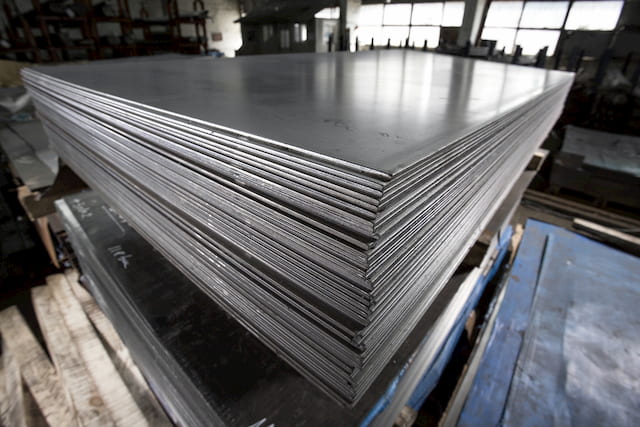Introduction
Mild steel is a kind of carbon steel that has very little carbon in it. Mild steel is also called “low carbon steel.” Depending on the source, it has between 0.05% and 0.25% carbon by weight. Higher-carbon steels, on the other hand, usually have between 0.30 and 2.0% carbon. If more carbon is added than that, the steel changes into cast iron.
Mild steel is not alloy steel, so it doesn’t have a lot of other things in it besides iron. It doesn’t have enough chromium, molybdenum, and other metals that make steel stronger. Because it has low amounts of carbon and alloying elements, it has a few qualities that set it apart from steels with higher amounts of carbon and alloying elements.
Mild steel is usually easier to bend, cut, and weld than high carbon steel and other steel because it has less carbon in it. This also makes it almost impossible to harden and strengthen by heating and cooling. Due to its low carbon content, it has very little carbon and other alloying elements that prevent dislocations in its crystal structure. Because of this, its tensile strength is often lower than that of high carbon and alloy steels. Mild steel is magnetic because it has a lot of iron and ferrite in it.
Since mild steel doesn’t have the alloying parts that stainless steel does, the iron in mild steel can rust if it isn’t coated properly. Mild steel isn’t as expensive as other types of steel because it doesn’t have as many alloying elements. It is popular steel among consumers because it is cheap, easy to work with, and easy to weld.
Technical Specifications of Mild Steel
| Designation | Depth of Section | Width of Flange | Thickness of Web | Weight/Mtr | Sectional Area | Moduli of Section | Moduli of Section |
| h | b | t | w | a | Zxx | Zyy | |
| (mm) | (mm) | (mm) | (kg) | (cm2) | (cm2) | (cm2) | |
| ISMC 75 weight | 75 | 40 | 4.8 | 7.1 | 9.1 | 20.3 | 4.7 |
| ISMC 100 weight | 100 | 50 | 5 | 9.6 | 12.2 | 37.3 | 7.5 |
| ISMC 125 weight | 125 | 65 | 5.3 | 13.1 | 16.7 | 68 | 13.4 |
| ISMC 150 weight | 150 | 75 | 5.7 | 16.8 | 21.3 | 105 | 19.4 |
| ISMC 175 weight | 175 | 75 | 6 | 19.6 | 24.4 | 139.8 | 22.8 |
| ISMC 200 weight | 200 | 75 | 6.2 | 22.3 | 28.5 | 181 | 26.4 |
| ISMC 250 weight | 250 | 82 | 7.2 | 34.2 | 39 | 307 | 38.4 |
| ISMC 300 weight | 300 | 90 | 7.8 | 36.3 | 46.3 | 428 | 47.1 |
| ISMC 400 weight | 400 | 100 | 8.8 | 50.1 | 63.8 | 760 | 67 |
Why would you use Mild Steel?
Mild steel is one of the most common kinds of steel because it can be used for so many different things in the industry. Mild steel is used to build buildings, make signs, make cars, make furniture, and build fences, among other things. Check out the list below to learn more about the different kinds of projects that work well with low-carbon steel:
Steel Frame Buildings – Mild steel beams are often used for building frames because they are strong.
Gates and Fencing – Mild steel gates and fences are both safe and look good, which is important for these two things. Low-carbon steel is hard to break, and you can coat, prime, or galvanize it to keep it from rusting and make it look nice.
Machinery Parts – One of the benefits of low-carbon steel is that it can be shaped into many different shapes. This makes it a great place to make steel sheets for car body kits and other industrial components.
Pipelines – When people need steel pipes for different reasons, they often choose mild steel tubes. This is because the pipes are very ductile, which makes them easy to weld and flexible enough to handle pressure without breaking. These pipes can also be insulated so that they continue to work no matter what the weather is like. This helps to increase the pipes’ durability.
Structural Steel – When structural steel fabrication is needed, low-carbon steel can be used because it has a consistent yield strength and is easier to shape. Mild steel can be easier to work with and cheaper than structural steel for smaller building projects.
Classifications of Mild Steel
EN 1.0301 – This grade of steel is easy to weld because it has 0.1% carbon, 0.4% manganese, and 0.4% silicon, along with a few other elements. EN 1.0301 is often used to make furniture, appliances, and car parts because of these qualities.
EN 1.1121 – This type of low-carbon steel has an average of 0.1% carbon and 0.45% manganese. This gives EN 1.1121 a very high level of ductility, which can be used in many different ways.
GET IN TOUCH WITH US FOR A FREE ESTIMATE TODAY
Read More :
DIFFERENCE BETWEEN UNS S32205 AND S31803: UNS S31803 and S32205 denote alloys with more similarities than differences. Firstly, they are both stainless steel with identical elemental components
HASTELLOY AND INCOLOY: Both Hastelloy and Incoloy belong to the “superalloy” family, commonly known as high-performance alloys. As a result, they share a number of common qualities.


